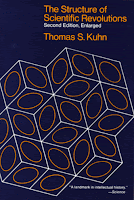Brookhaven National Laboratory
HOT A computer rendition of 4-trillion-degree Celsius quark-gluon plasma created in a demonstration of what scientists suspect shaped cosmic history.
In Brookhaven Collider, Scientists Briefly Break a Law of Nature
The Brookhaven scientists and their colleagues discussed their latest results from RHIC in talks and a news conference at a meeting of the American Physical Society Monday in Washington, and in a pair of papers submitted to Physical Review Letters. “This is a view of what the world was like at 2 microseconds,” said Jack Sandweiss of Yale, a member of the Brookhaven team, calling it, “a seething cauldron.”
Among other things, the group announced it had succeeded in measuring the temperature of the quark-gluon plasma as 4 trillion degrees Celsius, “by far the hottest matter ever made,” Dr. Vigdor said. That is 250,000 times hotter than the center of the Sun and well above the temperature at which theorists calculate that protons and neutrons should melt, but the quark-gluon plasma does not act the way theorists had predicted.
Instead of behaving like a perfect gas, in which every quark goes its own way independent of the others, the plasma seemed to act like a liquid. “It was a very big surprise,” Dr. Vigdor said, when it was discovered in 2005. Since then, however, theorists have revisited their calculations and found that the quark soup can be either a liquid or a gas, depending on the temperature, he explained. “This is not your father’s quark-gluon plasma,” said Barbara V. Jacak, of the State University at Stony Brook, speaking for the team that made the new measurements.
It is now thought that the plasma would have to be a million times more energetic to become a perfect gas. That is beyond the reach of any conceivable laboratory experiment, but the experiments colliding lead nuclei in the Large Hadron Collider outside Geneva next winter should reach energies high enough to see some evolution from a liquid to a gas.
See more at above link.
***
Violating Parity with Quarks and Gluons
by
Sean Carroll of Cosmic Variance
This new result from RHIC doesn’t change that state of affairs, but shows how quarks and gluons can violate parity spontaneously if they are in the right environment — namely, a hot plasma with a magnetic field.
So, okay, no new laws of physics. Just a much better understanding of how the existing ones work! Which is most of what science does, after all.
***
Quark–gluon plasma
From Wikipedia, the free encyclopedia
A
quark-gluon plasma (QGP) or
quark soup[1] is a
phase of
quantum chromodynamics (QCD) which exists at extremely high
temperature and/or
density. This phase consists of (almost) free
quarks and
gluons, which are the basic building blocks of matter. Experiments at
CERN's
Super Proton Synchrotron (SPS) first tried to create the QGP in the 1980s and 1990s: the results led CERN to announce indirect evidence for a "new state of matter"
[2] in 2000. Current experiments at
Brookhaven National Laboratory's
Relativistic Heavy Ion Collider (RHIC) are continuing this effort.
[3] Three new experiments running on
CERN's
Large Hadron Collider (LHC),
ALICE,
[4] ATLAS and
CMS, will continue studying properties of QGP.
Contents- 1 General introduction
- 1.1 Why this is referred to as "plasma"
- 1.2 How the QGP is studied theoretically
- 1.3 How it is created in the lab
- 1.4 How the QGP fits into the general scheme of physics
- 2 Expected properties
- 2.1 Thermodynamics
- 2.2 Flow
- 2.3 Excitation spectrum
- 3 Experimental situation
- 4 Formation of quark matter
- 5 See also
- 6 References
- 7 External links
|
General introduction
The quark-gluon plasma contains
quarks and
gluons, just as normal (
baryonic) matter does. The difference between these two phases of
QCD is that in normal matter each quark either pairs up with an anti-
quark to form a
meson or joins with two other quarks to form a
baryon (such as the
proton and the
neutron). In the QGP, by contrast, these mesons and baryons lose their identities and dissolve into a fluid of quarks and gluons.
[5] In normal matter quarks are
confined; in the QGP quarks are
deconfined.
Although the experimental high temperatures and densities predicted as producing a quark-gluon plasma have been realized in the laboratory, the resulting matter does
not behave as a quasi-ideal state of free quarks and gluons, but, rather, as an almost perfect dense fluid.
[6] Actually the fact that the quark-gluon plasma will not yet be "free" at temperatures realized at present accelerators had been predicted already in 1984
[7] as a consequence of the remnant effects of confinement.
Why this is referred to as "plasma"
A
plasma is matter in which
charges are
screened due to the presence of other mobile charges; for example:
Coulomb's Law is modified to yield a distance-dependent charge. In a QGP, the
color charge of the
quarks and
gluons is screened. The QGP has other analogies with a normal plasma. There are also dissimilarities because the color charge is non-
abelian, whereas the
electric charge is abelian. Outside a finite volume of QGP the color electric field is not screened, so that volume of QGP must still be color-neutral. It will therefore, like a nucleus, have integer electric charge.
How the QGP is studied theoretically
One consequence of this difference is that the
color charge is too large for
perturbative computations which are the mainstay of
QED. As a result, the main theoretical tools to explore the theory of the QGP is
lattice gauge theory. The transition temperature (approximately 175
MeV) was first predicted by lattice gauge theory. Since then lattice gauge theory has been used to predict many other properties of this kind of matter. The
AdS/CFT correspondence is a new interesting conjecture allowing insights in QGP.
How it is created in the lab
The QGP can be created by heating matter up to a
temperature of 2×10
12 kelvin, which amounts to 175
MeV per particle. This can be accomplished by colliding two large nuclei at high energy (note that 175 MeV is not the energy of the colliding beam).
Lead and
gold nuclei have been used for such collisions at
CERN SPS and
BNL RHIC, respectively. The nuclei are accelerated to
ultrarelativistic speeds and slammed into each other while
Lorentz contracted. They largely pass through each other, but a resulting hot volume called a
fireball is created after the collision. Once created, this fireball is expected to expand under its own
pressure, and cool while expanding. By carefully studying this flow, experimentalists hope to put the theory to test.
How the QGP fits into the general scheme of physics
QCD is one part of the modern theory of
particle physics called the
Standard Model. Other parts of this theory deal with
electroweak interactions and
neutrinos. The
theory of electrodynamics has been tested and found correct to a few parts in a trillion. The
theory of weak interactions has been tested and found correct to a few parts in a thousand. Perturbative aspects of QCD have been tested to a few percent. In contrast, non-perturbative aspects of QCD have barely been tested. The study of the QGP is part of this effort to consolidate the grand theory of particle physics.
The study of the QGP is also a testing ground for
finite temperature field theory, a branch of theoretical physics which seeks to understand particle physics under conditions of high temperature. Such studies are important to understand the early evolution of our universe:
the first hundred microseconds or so. While this may seem
esoteric, this is crucial to the physics goals of a new generation of observations of the universe (
WMAP and its successors). It is also of relevance to
Grand Unification Theories or 'GUTS' which seek to unify the four fundamental forces of nature.
Expected properties
Thermodynamics
The cross-over temperature from the normal hadronic to the QGP phase is about 175
MeV, corresponding to an energy density of a little less than 1
GeV/
fm3. For
relativistic matter, pressure and temperature are not independent variables, so the
equation of state is a relation between the energy density and the pressure. This has been found through
lattice computations, and compared to both
perturbation theory and
string theory. This is still a matter of active research. Response functions such as the
specific heat and various quark number susceptibilities are currently being computed.
Flow
The equation of state is an important input into the flow equations. The
speed of sound is currently under investigation in lattice computations. The
mean free path of quarks and gluons has been computed using
perturbation theory as well as
string theory.
Lattice computations have been slower here, although the first computations of
transport coefficients have recently been concluded. These indicate that the
mean free time of quarks and gluons in the QGP may be comparable to the average interparticle spacing: hence the QGP is a liquid as far as its flow properties go. This is very much an active field of research, and these conclusions may evolve rapidly. The incorporation of dissipative phenomena into hydrodynamics is another recent development that is still in an active stage.
Excitation spectrum
Does the QGP really contain (almost) free quarks and gluons? The study of thermodynamic and flow properties would indicate that this is an over-simplification. Many ideas are currently being evolved and will be put to test in the near future. It has been hypothesized recently that some mesons built from heavy quarks (such as the
charm quark) do not dissolve until the temperature reaches about 350
MeV. This has led to speculation that many other kinds of bound states may exist in the plasma. Some static properties of the plasma (similar to the
Debye screening length) constrain the excitation spectrum.
Experimental situation
Those aspects of the QGP which are easiest to compute are not the ones which are the easiest to probe in experiments. While the balance of evidence points towards the QGP being the origin of the detailed properties of the fireball produced in the
RHIC, this is the main barrier which prevents experimentalists from declaring a sighting of the QGP. For a summary see
2005 RHIC Assessment.
The important classes of experimental observations are
Formation of quark matter
In April 2005, formation of quark matter was tentatively confirmed by results obtained at
Brookhaven National Laboratory's
Relativistic Heavy Ion Collider (RHIC). The consensus of the four RHIC research groups was that they had created a quark-gluon
liquid of very low
viscosity. However, contrary to what was at that time still the widespread assumption, it is yet unknown from theoretical predictions whether the QCD "plasma", especially close to the transition temperature, should behave like a gas or liquid
[8]. Authors favoring the weakly interacting interpretation derive their assumptions from the lattice QCD calculation, where the entropy density of quark-gluon plasma approaches the weakly interacting limit. However, since both energy density and correlation shows significant deviation from the weakly interacting limit, it has been pointed out by many authors that there is in fact no reason to assume a QCD "plasma" close to the transition point should be weakly interacting, like electromagnetic plasma (see, e.g.,
[9]).
See also
References
External links



















